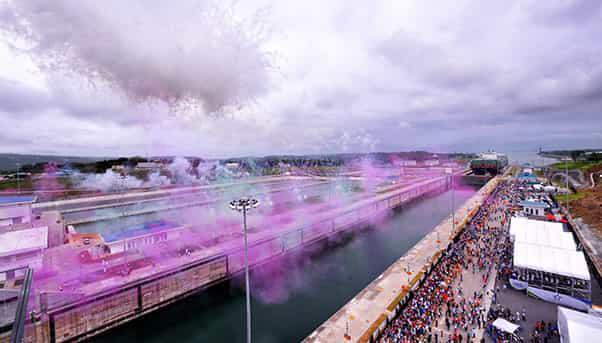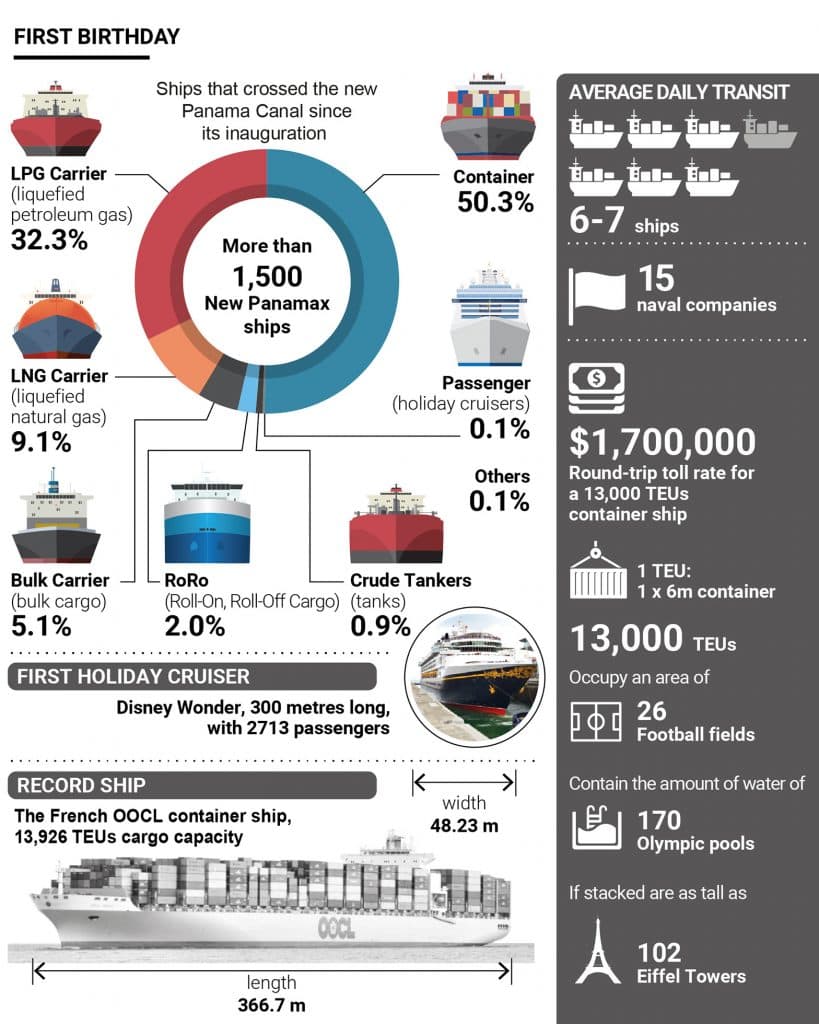
Panama’s new canal has accomplished its first year of operation, with one result that gives it plenty of reason to celebrate: since it opened on June 26, 2016, the canal has had more than 1,500 New Panamax ships sail through its enormous locks. These giants of the high seas measure 360 metres in length with a cargo hold three times as big as those of the ships that used the old canal for more than a century.
It is a result that Panamanian President Juan Carlos Varela proudly presented to U.S. President Donald Trump during an official visit to the White House on June 19.
Officials from the Panama Canal Authority has proposed modifications to its toll system to encourage more shipping lines from the United States to use the canal by offering a discount to those that do round trips through it.
«The Canal expansion has benefitted its users, Panama and world trade. In addition to augmenting the Canal capacity, it has improved Canal services to the maritime industry and world trade flows, and facilitated the movement of goods between important markets,» its proposal reads. «Canal customers have benefited from the resulting economies of scale from deploying larger vessels. Likewise, the Canal expansion has allowed Panama to become the transportation and logistics hub of the Americas, thereby strengthening the all-water route through the Panama Canal.»
Infrastructure as Source of Wealth
The passage of more ships through Panama – thanks to the opening of the second canal – has not only facilitated global trade but also led to a further development of Panama itself. Each ship that carries 13,000 TEUs (TEU meaning 20-foot equivalent unit) pays $850,000 to the Authority for the right of passage. Part of this toll is used to cover the cost of running and maintaining the infrastructure (let alone the Authority’s costs), while the rest goes to the Panamanian state. In the first 10 months of the canal’s operation, it brought in $525 million for the state by handling an average of five ships a day. Thanks to the smooth operation of the sluice gates designed and built in Italy, this average beat expectations by eventually rising to 6-7 ships a day.
On June 20, six days before the anniversary, the Cosco Glory loaded with 13,435 TEUs became the 1,500th ship to sail through the canal. Its passage followed that of 760 container ships, 490 liquefied petroleum gas (LPG) carriers and 140 liquefied natural gas (LNG) carriers, among other categories of New Panamax ships.
The efficiency of the canal system also led to the Authority opening passage to holiday cruise ships, which had been too big to pass through the old canal opened in 1914. The first one to accept the invitation was the Disney Wonder, 300 metres long with 2,713 people onboard.

A Facilitator of Global Trade
The new canal appears to be reaching the Authority’s objective: to increase Panama’s quota of maritime trade from 3% to 6%. Since the new canal has not replaced but rather joined the old canal in serving ships from all over the world, traffic through the isthmus is rising. The old canal handled the passage of $270 billion worth of goods every year, goods that would later reach 1,700 ports in 150 countries. This number has obviously been exceeded with the opening of the new canal. Under the new toll system being proposed by the Authority, ships that use the new canal again for their return to Asia after dropping off their cargo would enjoy a 6% discount on the cost of the round trip. The offer is designed to encourage more shipping lines to make their return trip through Panama (15 have signed up in the first year) rather than choose the Suez Canal or the Cape of Good Hope in Africa to get home.
A Success Foretold
The commercial success of the new canal is due to the exceptional work behind the infrastructure. It was on July 15, 2009, when the Authority signed the contract to have Grupo Unidos por el Canal (GUPC), the consortium led by Salini Impregilo, build the new canal. The construction site would reach gigantic proportions: 74 million cubic metres of dug earth, five million cubic metres of concrete and 200,000 tonnes of steel and more than 100 million working hours.
The opening and closing of the sluice gates, accompanied by the filling and emptying of the water basins next to the canal, guaranteed the raising and lowering of ships coming to and from Gatun Lake located above sea level.
To enter the lake, a ship is raised 27 metres before entering it. To leave the lake after crossing it, the ship is then lowered by the same amount at the set of locks on the opposite coast. The movement of the sluice gates are a mechanical and technological wonder because each manoeuver, with the passage of a ship, has to be done with infinitesimal precision, each gate completing its function in just five minutes or less.
It took seven years for 30,000 people to complete the project. Some 90% of those people were from the region. Their commitment, inspired by GUPC’s engineering excellence, made possible the completion of a unique piece of infrastructure that has not only contributed to Panama’s development but also that of global trade.

